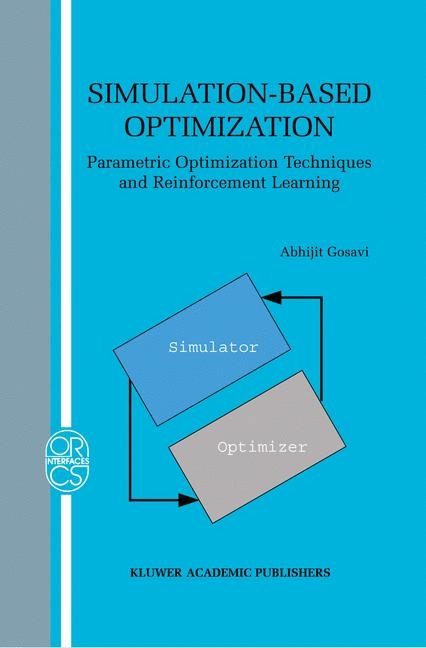
Simulation-based Optimization
Kluwer Academic Publishers (Verlag)
978-1-4020-7454-7 (ISBN)
- Titel erscheint in neuer Auflage
- Artikel merken
Simulation-Based Optimization: Parametric Optimization Techniques and Reinforcement Learning introduces the evolving area of simulation-based optimization. The book's objective is two-fold: (1) It examines the mathematical governing principles of simulation-based optimization, thereby providing the reader with the ability to model relevant real-life problems using these techniques. (2) It outlines the computational technology underlying these methods. Taken together these two aspects demonstrate that the mathematical and computational methods discussed in this book do work. Broadly speaking, the book has two parts: (1) parametric (static) optimization and (2) control (dynamic) optimization. Some of the book's special features are: *An accessible introduction to reinforcement learning and parametric-optimization techniques. *A step-by-step description of several algorithms of simulation-based optimization. *A clear and simple introduction to the methodology of neural networks. *A gentle introduction to convergence analysis of some of the methods enumerated above. *Computer programs for many algorithms of simulation-based optimization.
List of Figures. List of Tables. Acknowledgements. Preface. 1. Background. 1.1. Why this book was written. 1.2. Simulation-based optimization and modern times. 1.3. How this book is organized. 2. Notation. 2.1. Chapter Overview. 2.2. Some basic conventions. 2.3. Vector notation. 2.4. Notation for matrices. 2.5. Notation for n-tuples. 2.6. Notation for sets. 2.7. Notation for sequences. 2.8. Notation for transformations. 2.9. Max, min and arg max. 2.10. Acronyms and abbreviations. 3. Probability theory: a refresher.3.1. Overview of this chapter. 3.2. Laws of probability. 3.3. Probability distributions. 3.4. Expected value of a random variable. 3.5. Standard deviation of a random variable. 3.6. Limit theorems. 3.7. Review questions. 4. Basic concepts underlying simulation. 4.1. Chapter overview. 4.2. Introductions. 4.3. Models. 4.4. Simulation modeling of random systems. 4.5. Concluding remarks. 4.6. Historical remarks. 4.7. Review questions. 5. Simulation optimization: an overview. 5.1. Chapter overview. 5.2. Stochastic parametric optimization. 5.3. Stochastic control optimization. 5.4. Historical remarks. 5.5. Review questions. 6. Response surfaces and neural nets. 6.1. Chapter overview. 6.2. RSM: an overview. 6.3. RSM: details. 6.4. Neuro-response surface methods. 6.5. Concluding remarks. 6.6. Bibliographic remarks. 6.7. Review questions. 7. Parametric optimization. 7.1. Chapter overview. 7.2. Continuous optimization. 7.3. Discrete optimization. 7.4. Hybrid solution spaces. 7.5. Concluding remarks. 7.6. Bibliographic remarks. 7.7. Review questions. 8. Dynamic programming. 8.1. Chapter overview. 8.2. Stochastic processes. 8.3. Markov processes, Markov chains and semi-Markov processes. 8.4. Markov decision problems. 8.5. How to solve an MDP using exhaustive enumeration. 8.6. Dynamic programming for average reward. 8.7. Dynamic programming and discounted reward. 8.8. The Bellman equation: an intuitive perspective. 8.9. Semi-Markov decision problems. 8.10. Modified policy iteration. 8.11. Miscellaneous topics related to MDPs and SMDPs. 8.12. Conclusions. 8.13. Bibliographic remarks. 8.14. Review questions. 9. Reinforcement learning. 9.1. Chapter overview. 9.2. The need for reinforcement learning. 9.3. Generating the TPM through straightforward counting. 9.4. Reinforcement learning: fundamentals. 9.5. Discounted reward reinforcement learning. 9.6. Average reward reinforcement learning. 9.7. Semi-Markov decision problems and RL. 9.8. RL algorithms and their DP counterparts. 9.9. Act
| Erscheint lt. Verlag | 30.6.2003 |
|---|---|
| Reihe/Serie | Operations Research /Computer Science Interfaces Series ; 25 |
| Zusatzinfo | biography |
| Sprache | englisch |
| Maße | 156 x 234 mm |
| Gewicht | 995 g |
| Themenwelt | Informatik ► Grafik / Design ► Digitale Bildverarbeitung |
| Mathematik / Informatik ► Informatik ► Theorie / Studium | |
| Mathematik / Informatik ► Mathematik ► Angewandte Mathematik | |
| Mathematik / Informatik ► Mathematik ► Finanz- / Wirtschaftsmathematik | |
| ISBN-10 | 1-4020-7454-9 / 1402074549 |
| ISBN-13 | 978-1-4020-7454-7 / 9781402074547 |
| Zustand | Neuware |
| Haben Sie eine Frage zum Produkt? |
aus dem Bereich


